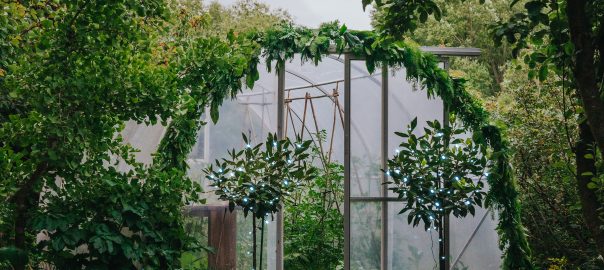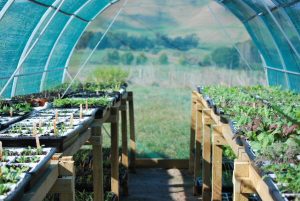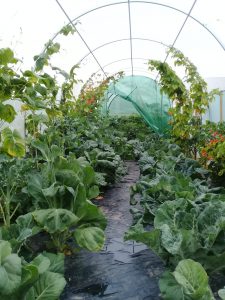
DECEMBER IN THE TUNNELHOUSE- EYES ON THE BALL!
May 24, 2023
DECEMBER IN THE TUNNELHOUSE – EYES ON THE BALL!
December in the tunnelhouse
Welcome to Morrifield’s monthly garden guide where we go undercover to bring you the best tips and tasks for great greenhouse growing. Early summer is make or break time in the greenhouse. What you do now will impact the health of your heat-lovers for the rest of the season, and even into autumn. So don’t let down your guard – when it comes to feeding, watering, ventilating, and heat and insect management – keep your eye on the ball!
Morrifield’s Gardening Zones
Our long maritime country is filled with exciting microclimates. That means your gardening zone may be quite different to your neighbour’s, just a few kilometres away. Use our simple descriptions to help gauge which undercover zone sounds like you!
Zone 1 (Warm Winters, Hot Summers)
Zone 2 (Mild Winters, Hot Summers)
Zone 3 (Cold Winters, Mild Summers)
Zone 4 (Severe Winters, Hot Summers)
Top Tasks Around the Country
Zones 1, 2 & 4
Shading from the Sun
In spring, we welcome into our greenhouses all the heat we can get, but in summer, there can come a point where it can become extremely humid. Generally speaking, ‘too hot’ is thought of as being above 32°C. Beyond this temperature, plants are under stress, and can quickly wilt and dry out, placing them at serious risk of pest attack. You can help prevent this situation by installing shadecloth or by adding extra ventilation to your greenhouse in advance. This can be in the form of an additional vent, window or door in the end for better ventilation. You will need to have all your ventilation open in the warmer months . Another option is a fan, there are solar units available and this will distribute the airflow and help to prevent disease especially if there is no wind on a hot summers day.

All zones
Sunscald
Rather than being a disease, sunscald occurs when green (and sometimes ripe) fruit is exposed to the intense rays of the sun. It can occur even in cooler parts of the country when diseased foliage has been removed, or to allow for the movement of air. Once fruit is scalded by the sun, the damaged parts become pale and then papery, at which point the fruit can start to decay – a sure invitation for disease to set up home. If your fruit must be directly exposed to the sun, for whatever reason, consider shading it with sections of dark, lightweight cloth such as shade cloth or a cotton voile, held in place with a light paperclip or clothes peg (don’t attach these to the plant, only to the fabric itself). Some lightly scalded fruit will survive, but if not, remove it immediately.
Replacement plants
Climate change alters everything we know about gardening, but one thing we are growing used to is that our summers are arriving later and later. Consequently, greenhouse plants that go in the ground in October or November, may not produce until mid or late summer, by which time they are tired and looking past their best. Meanwhile, there are still 3 good months of heat left to go! That’s why it pays to have replacement plants in the wings. Start a new round of cucumber seed off this month, along with seedling tomatoes grown from laterals taken from your existing plants. Laterals are the small ‘branches’ that grow from between the leaf branches and the main stem. On indeterminate tomato plants they should be removed. When you do remove them, pop a few of the strongest into a glass of water. Once they grow roots, gently pot them up in good quality potting mix, and grow them on to replace tomato plants that become diseased or tired.

Tap, don’t shake!
Tomato plants are self pollinating. This means they don’t require insects to pollinate their flowers (although some insects do assist). Rather, pollination occurs when the flowers are vibrated, causing their pollen to fall from one flower to another. Wind can assist with this vibration . Insects can help by vibrating flowers when they visit them, but one of the best helpers is you, the gardener! By lightly tapping your tomato plants as you walk by them, you’ll help the pollen to dislodge and fall. Having said that, it is most important that you never shake your tomato vines. The main stem of the vine is filled with moisture, and as a result, its interior is lush and crisp. Shaking can easily damage the interior of the stem, something you may not be aware of until your plant begins to rot at the damaged point. So, be helpful, but be gentle!
Leaf removal
When you encourage air to flow around your greenhouse plants, you are helping to prevent a buildup of excess moisture, something that is a sure recipe for the arrival of fungal disease. Encourage good airflow by removing some of the lower leaves from bushy plants such as tomatoes. To do this methodically, remove all leaves below the lowest truss of ripe tomatoes as you harvest them (while you are at it, remove one or two leaves from above the next truss, to help with ripening). Also remove the lower leaves of cucumber plants as they become spent or diseased, and any failing foliage on aubergine and peppers.
Encourage air flow in the upper level of your greenhouse, too. This can be done by pinching out the growing tips of indeterminate tomato plants before they hit the ‘ceiling’ of the greenhouse, or by training them horizontally once they reach this point.

Caging
Airflow is also encouraged when bushing greenhouse plants (such as determinate tomatoes, pepino, Cape gooseberry, basils, and courgette), are confined to ‘cages’. Make your own with sticks of bamboo and twine, or buy commercial ones from a garden centre. They are worth their weight in gold. When not required, store any that are made of plastic in dark place to extend their life.

Beat the blossom-end rot
It can be so disheartening to discover blossom-end rot in your tomatoes, especially as the disorder (a blackening and softening at the opposite end of the calyx) often occurs in the first fruit of the season, just as it is reaching maturity. Blossom-end rot is frequently blamed on over-watering, and although this is related to the issue, it is not the underlying reason.
The cause of blossom-end rot is a lack of calcium in the plant (sources of calcium include bone meal and gypsum). Even if sufficient calcium is present in your greenhouse soil, your tomato plants cannot take it up if they are over or under watered. So, the secret to preventing blossom-end rot is to water regularly and carefully (this may be 3 to 4 times a week in the heat of summer, or everyday if you are growing in pots). Water when the top 3cm of soil is dry to the touch. Add the water slowly, and let it sink well down into the soil before moving on to the next plant. Remember, a plant can wilt because of too much, as well as too little, moisture. So always check the soil with you finger!
Late starters
Wherever you are in the country, don’t be afraid to start planting your greenhouse out now – it’s not too late! In fact, in high altitude regions of the country, planting is only just beginning, and in cooler regions, basil, capsicum, and aubergine doesn’t begin to thrive until the temperatures rise significantly. However, if you don’t yet have your seedlings raised, head to the garden centre for them so they get the head start they need.
Sow me undercover now
Zones 1 and 2
Aubergine, capsicum, cucumber, peanut, tomato.
Zones 3 and 4
Basil, Cape gooseberry, corn, courgettes (in seed pots), cumin, dwarf beans, fenugreek, lemongrass, peanut, pumpkin.
Transplant me undercover now
All zones
Aubergine, capsicum, chilly, cucumber, melon, passion fruit, tomato, zucchini.
Zones 3 & 4
Dwarf beans, basil, corn, pumpkin (train under the greenhouse, and outside) zucchini.
News and views
One of our customers is enjoying his new Crop Protection Tunnelhouse and had bought a budget greenhouse for all of his more delicate plants and has the best of both worlds! He has put the greenhouse inside his Morrifield Crop House.

He has the protection from the White Butterfly and pests from his Crop house and can grow all his Brassica, but the warmth of the additional tunnelhouse on the inside.
